British vs Lebanese Community Comparison
COMPARE
British
Lebanese
Social Comparison
Social Comparison
British
Lebanese
8,012
SOCIAL INDEX
77.6/ 100
SOCIAL RATING
92nd/ 347
SOCIAL RANK
7,328
SOCIAL INDEX
70.8/ 100
SOCIAL RATING
122nd/ 347
SOCIAL RANK
Lebanese Integration in British Communities
The statistical analysis conducted on geographies consisting of 391,174,537 people shows a moderate positive correlation between the proportion of Lebanese within British communities in the United States with a correlation coefficient (R) of 0.412. On average, for every 1% (one percent) increase in British within a typical geography, there is an increase of 0.121% in Lebanese. To illustrate, in a geography comprising of 100,000 individuals, a rise of 1,000 British corresponds to an increase of 120.8 Lebanese.
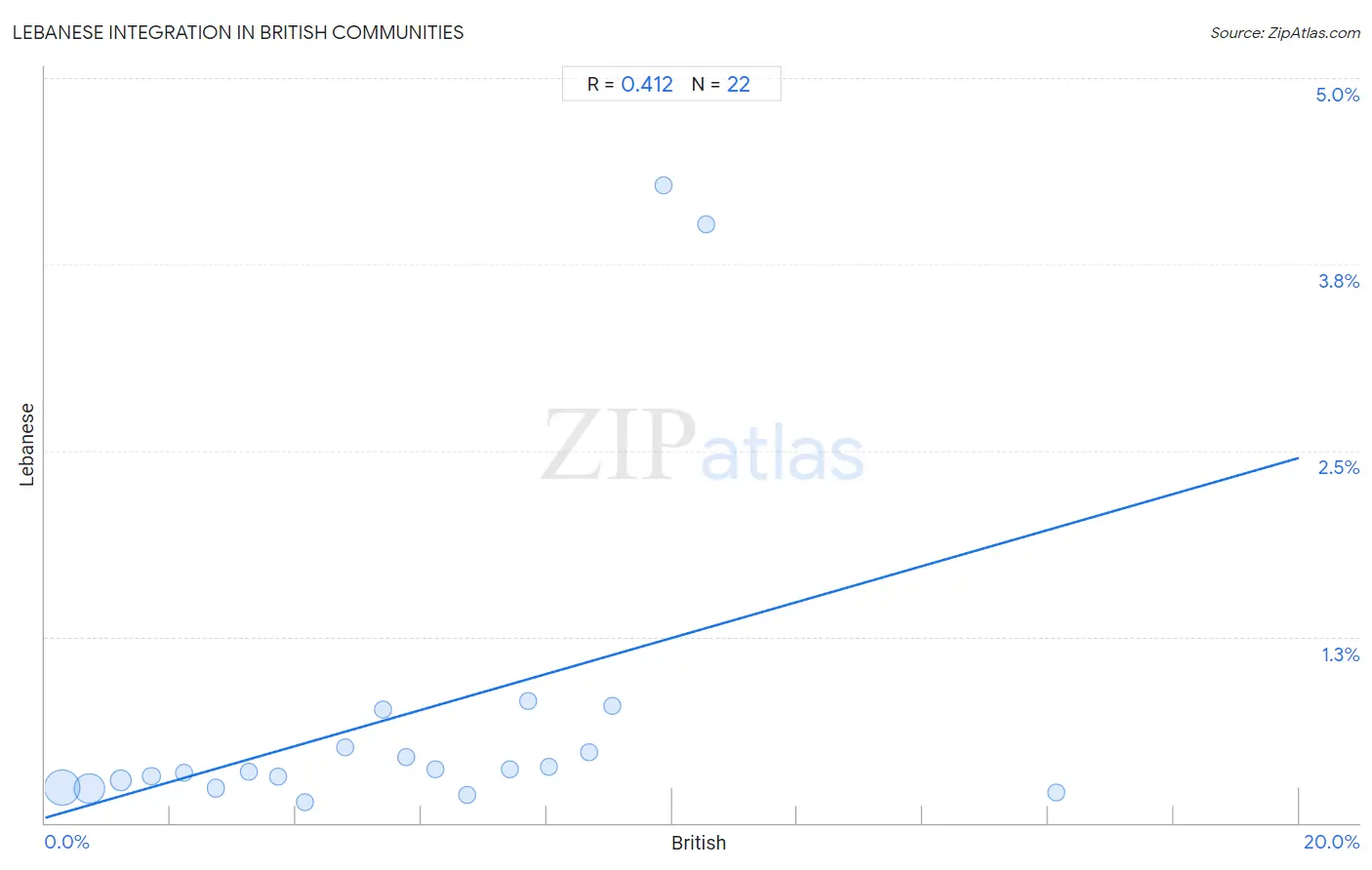
British vs Lebanese Income
When considering income, the most significant differences between British and Lebanese communities in the United States are seen in wage/income gap (28.9% compared to 27.9%, a difference of 3.7%), householder income over 65 years ($63,940 compared to $62,287, a difference of 2.6%), and householder income under 25 years ($51,477 compared to $50,355, a difference of 2.2%). Conversely, both communities are more comparable in terms of median earnings ($48,189 compared to $48,226, a difference of 0.080%), median female earnings ($39,772 compared to $40,006, a difference of 0.59%), and median male earnings ($57,890 compared to $57,409, a difference of 0.84%).

| Income Metric | British | Lebanese |
| Per Capita Income | Exceptional $46,571 | Exceptional $45,840 |
| Median Family Income | Exceptional $108,705 | Exceptional $107,086 |
| Median Household Income | Exceptional $88,914 | Excellent $88,091 |
| Median Earnings | Exceptional $48,189 | Exceptional $48,226 |
| Median Male Earnings | Exceptional $57,890 | Exceptional $57,409 |
| Median Female Earnings | Average $39,772 | Good $40,006 |
| Householder Age | Under 25 years | Poor $51,477 | Tragic $50,355 |
| Householder Age | 25 - 44 years | Excellent $98,359 | Excellent $97,339 |
| Householder Age | 45 - 64 years | Exceptional $106,264 | Exceptional $104,734 |
| Householder Age | Over 65 years | Exceptional $63,940 | Good $62,287 |
| Wage/Income Gap | Tragic 28.9% | Tragic 27.9% |
British vs Lebanese Poverty
When considering poverty, the most significant differences between British and Lebanese communities in the United States are seen in married-couple family poverty (4.3% compared to 5.4%, a difference of 25.3%), receiving food stamps (9.7% compared to 11.1%, a difference of 14.3%), and family poverty (7.9% compared to 8.9%, a difference of 12.6%). Conversely, both communities are more comparable in terms of single male poverty (13.3% compared to 13.2%, a difference of 0.68%), single mother poverty (29.2% compared to 29.4%, a difference of 0.90%), and female poverty among 25-34 year olds (13.4% compared to 13.2%, a difference of 1.4%).
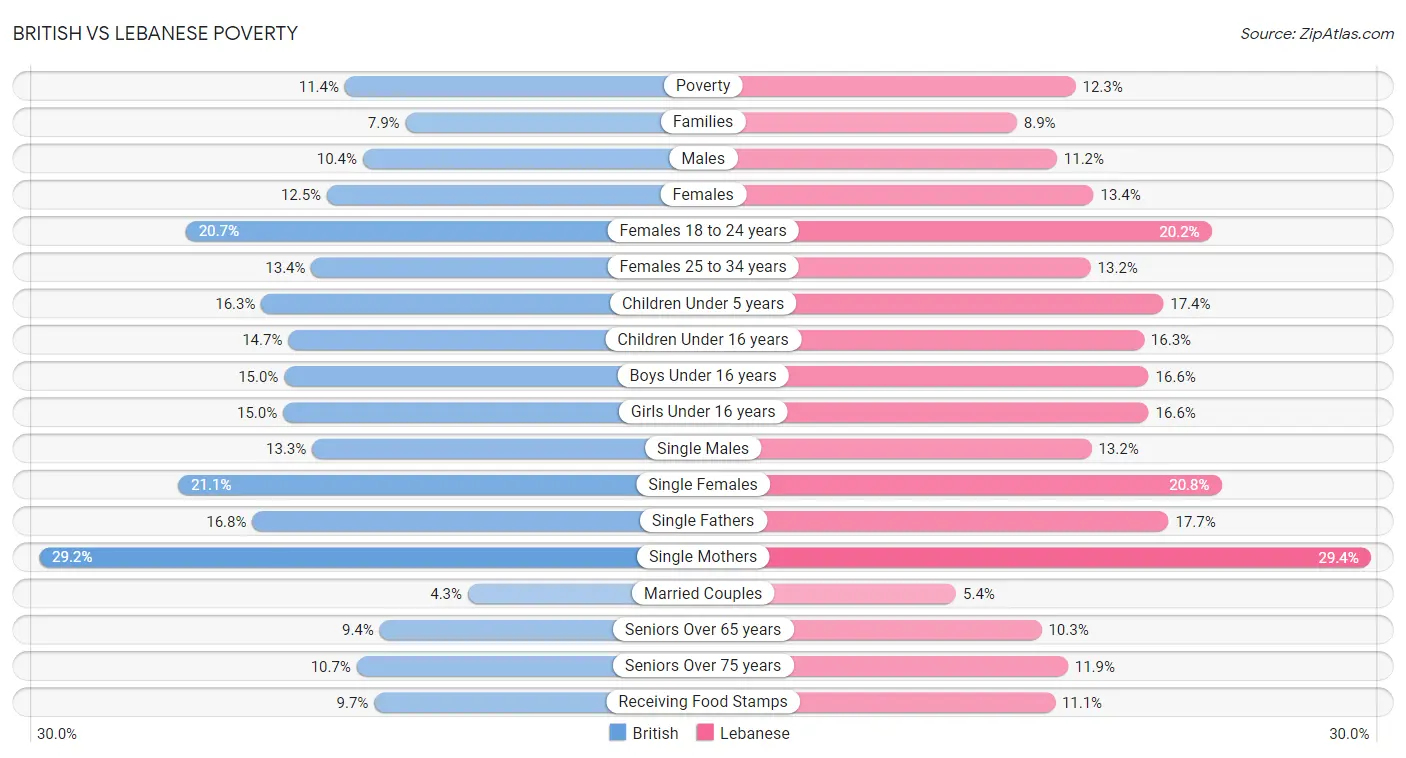
| Poverty Metric | British | Lebanese |
| Poverty | Exceptional 11.4% | Average 12.3% |
| Families | Exceptional 7.9% | Average 8.9% |
| Males | Exceptional 10.4% | Average 11.2% |
| Females | Exceptional 12.5% | Average 13.4% |
| Females 18 to 24 years | Tragic 20.7% | Average 20.2% |
| Females 25 to 34 years | Good 13.4% | Good 13.2% |
| Children Under 5 years | Excellent 16.3% | Average 17.4% |
| Children Under 16 years | Exceptional 14.7% | Average 16.3% |
| Boys Under 16 years | Exceptional 15.0% | Average 16.6% |
| Girls Under 16 years | Exceptional 15.0% | Average 16.6% |
| Single Males | Tragic 13.3% | Tragic 13.2% |
| Single Females | Average 21.1% | Good 20.8% |
| Single Fathers | Tragic 16.8% | Tragic 17.7% |
| Single Mothers | Average 29.2% | Fair 29.4% |
| Married Couples | Exceptional 4.3% | Fair 5.4% |
| Seniors Over 65 years | Exceptional 9.4% | Exceptional 10.3% |
| Seniors Over 75 years | Exceptional 10.7% | Good 11.9% |
| Receiving Food Stamps | Exceptional 9.7% | Excellent 11.1% |
British vs Lebanese Unemployment
When considering unemployment, the most significant differences between British and Lebanese communities in the United States are seen in unemployment (4.7% compared to 5.1%, a difference of 8.1%), male unemployment (4.8% compared to 5.2%, a difference of 7.7%), and unemployment among ages 35 to 44 years (4.4% compared to 4.7%, a difference of 7.6%). Conversely, both communities are more comparable in terms of unemployment among ages 16 to 19 years (16.5% compared to 16.4%, a difference of 0.17%), unemployment among ages 60 to 64 years (4.6% compared to 4.6%, a difference of 0.50%), and unemployment among ages 25 to 29 years (6.4% compared to 6.4%, a difference of 0.77%).
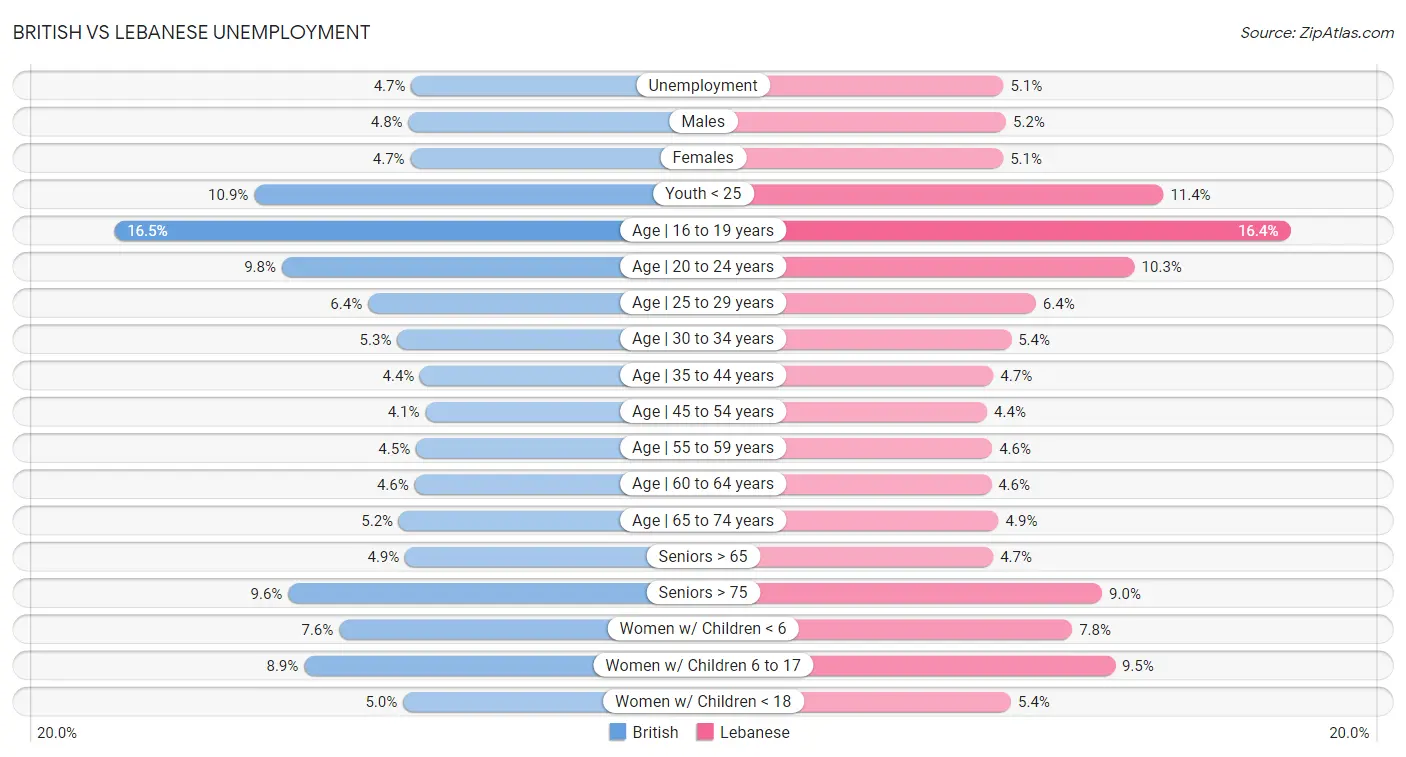
| Unemployment Metric | British | Lebanese |
| Unemployment | Exceptional 4.7% | Excellent 5.1% |
| Males | Exceptional 4.8% | Good 5.2% |
| Females | Exceptional 4.7% | Exceptional 5.1% |
| Youth < 25 | Exceptional 10.9% | Excellent 11.4% |
| Age | 16 to 19 years | Exceptional 16.5% | Exceptional 16.4% |
| Age | 20 to 24 years | Exceptional 9.8% | Average 10.3% |
| Age | 25 to 29 years | Exceptional 6.4% | Exceptional 6.4% |
| Age | 30 to 34 years | Excellent 5.3% | Good 5.4% |
| Age | 35 to 44 years | Exceptional 4.4% | Average 4.7% |
| Age | 45 to 54 years | Exceptional 4.1% | Excellent 4.4% |
| Age | 55 to 59 years | Exceptional 4.5% | Exceptional 4.6% |
| Age | 60 to 64 years | Exceptional 4.6% | Exceptional 4.6% |
| Age | 65 to 74 years | Exceptional 5.2% | Exceptional 4.9% |
| Seniors > 65 | Exceptional 4.9% | Exceptional 4.7% |
| Seniors > 75 | Tragic 9.6% | Poor 9.0% |
| Women w/ Children < 6 | Good 7.6% | Fair 7.8% |
| Women w/ Children 6 to 17 | Average 8.9% | Tragic 9.5% |
| Women w/ Children < 18 | Exceptional 5.0% | Good 5.4% |
British vs Lebanese Labor Participation
When considering labor participation, the most significant differences between British and Lebanese communities in the United States are seen in in labor force | age 16-19 (40.5% compared to 38.6%, a difference of 5.0%), in labor force | age 20-24 (76.7% compared to 75.3%, a difference of 1.8%), and in labor force | age 35-44 (84.2% compared to 83.6%, a difference of 0.69%). Conversely, both communities are more comparable in terms of in labor force | age 45-54 (82.6% compared to 82.5%, a difference of 0.10%), in labor force | age 30-34 (84.5% compared to 84.4%, a difference of 0.16%), and in labor force | age > 16 (64.7% compared to 64.5%, a difference of 0.18%).

| Labor Participation Metric | British | Lebanese |
| In Labor Force | Age > 16 | Tragic 64.7% | Tragic 64.5% |
| In Labor Force | Age 20-64 | Poor 79.3% | Tragic 79.1% |
| In Labor Force | Age 16-19 | Exceptional 40.5% | Exceptional 38.6% |
| In Labor Force | Age 20-24 | Exceptional 76.7% | Good 75.3% |
| In Labor Force | Age 25-29 | Good 84.7% | Poor 84.3% |
| In Labor Force | Age 30-34 | Fair 84.5% | Poor 84.4% |
| In Labor Force | Age 35-44 | Fair 84.2% | Tragic 83.6% |
| In Labor Force | Age 45-54 | Fair 82.6% | Poor 82.5% |
British vs Lebanese Family Structure
When considering family structure, the most significant differences between British and Lebanese communities in the United States are seen in births to unmarried women (30.8% compared to 29.5%, a difference of 4.3%), single father households (2.2% compared to 2.1%, a difference of 3.9%), and divorced or separated (12.3% compared to 11.9%, a difference of 3.2%). Conversely, both communities are more comparable in terms of family households (64.4% compared to 64.4%, a difference of 0.070%), family households with children (27.4% compared to 27.7%, a difference of 1.1%), and married-couple households (48.7% compared to 47.9%, a difference of 1.7%).

| Family Structure Metric | British | Lebanese |
| Family Households | Good 64.4% | Good 64.4% |
| Family Households with Children | Average 27.4% | Excellent 27.7% |
| Married-couple Households | Exceptional 48.7% | Exceptional 47.9% |
| Average Family Size | Tragic 3.13 | Tragic 3.19 |
| Single Father Households | Exceptional 2.2% | Exceptional 2.1% |
| Single Mother Households | Exceptional 5.8% | Exceptional 5.9% |
| Currently Married | Exceptional 48.8% | Exceptional 47.9% |
| Divorced or Separated | Poor 12.3% | Excellent 11.9% |
| Births to Unmarried Women | Good 30.8% | Exceptional 29.5% |
British vs Lebanese Vehicle Availability
When considering vehicle availability, the most significant differences between British and Lebanese communities in the United States are seen in no vehicles in household (7.6% compared to 8.7%, a difference of 14.0%), 4 or more vehicles in household (7.2% compared to 6.4%, a difference of 13.1%), and 3 or more vehicles in household (21.9% compared to 20.0%, a difference of 9.5%). Conversely, both communities are more comparable in terms of 1 or more vehicles in household (92.5% compared to 91.4%, a difference of 1.2%), 2 or more vehicles in household (60.0% compared to 57.6%, a difference of 4.3%), and 3 or more vehicles in household (21.9% compared to 20.0%, a difference of 9.5%).

| Vehicle Availability Metric | British | Lebanese |
| No Vehicles Available | Exceptional 7.6% | Exceptional 8.7% |
| 1+ Vehicles Available | Exceptional 92.5% | Exceptional 91.4% |
| 2+ Vehicles Available | Exceptional 60.0% | Exceptional 57.6% |
| 3+ Vehicles Available | Exceptional 21.9% | Good 20.0% |
| 4+ Vehicles Available | Exceptional 7.2% | Average 6.4% |
British vs Lebanese Education Level
When considering education level, the most significant differences between British and Lebanese communities in the United States are seen in no schooling completed (1.5% compared to 1.9%, a difference of 22.8%), doctorate degree (2.2% compared to 2.1%, a difference of 5.6%), and college, under 1 year (68.5% compared to 67.5%, a difference of 1.5%). Conversely, both communities are more comparable in terms of bachelor's degree (40.4% compared to 40.4%, a difference of 0.040%), associate's degree (48.9% compared to 48.8%, a difference of 0.12%), and professional degree (5.0% compared to 5.0%, a difference of 0.15%).
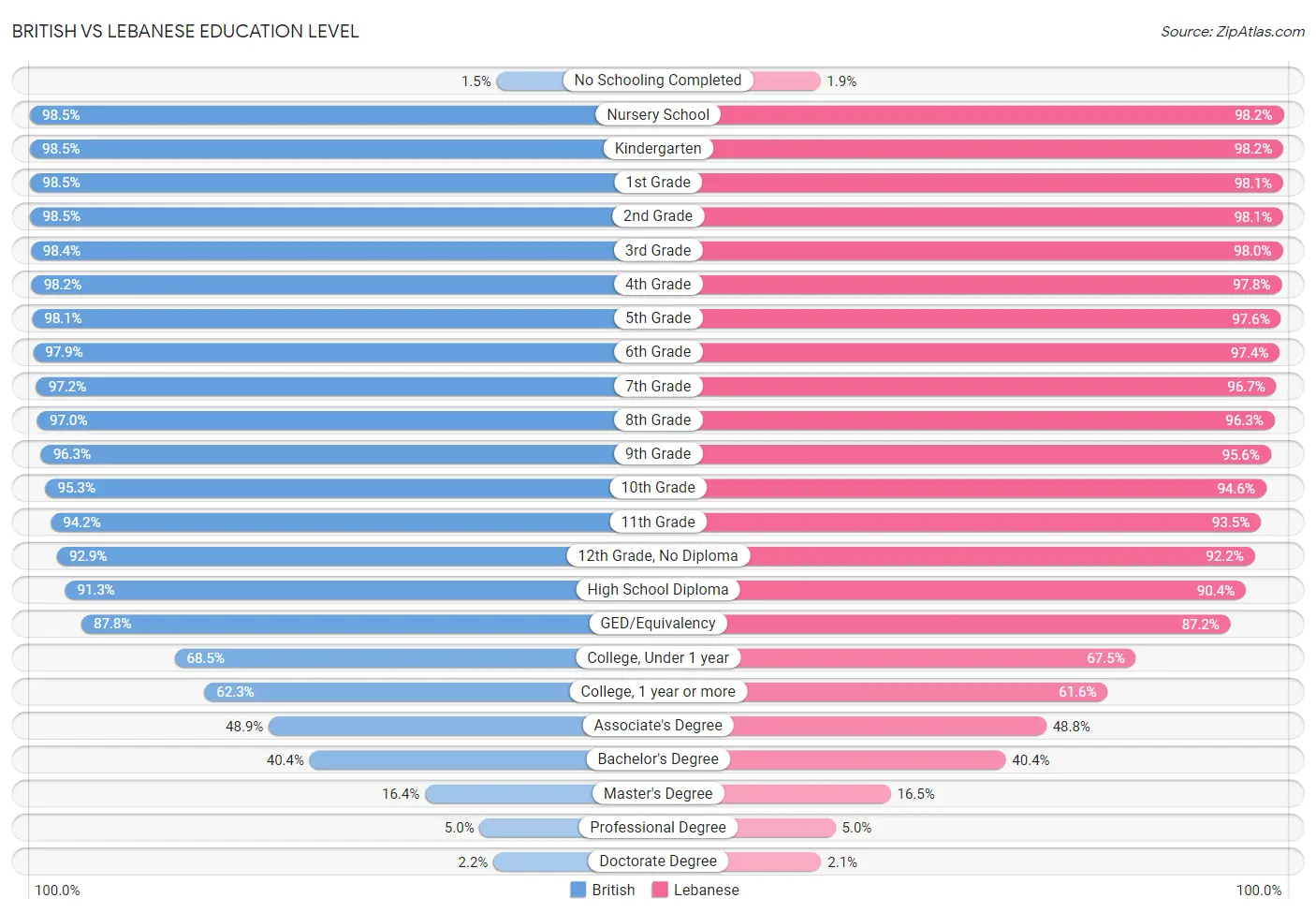
| Education Level Metric | British | Lebanese |
| No Schooling Completed | Exceptional 1.5% | Exceptional 1.9% |
| Nursery School | Exceptional 98.5% | Exceptional 98.2% |
| Kindergarten | Exceptional 98.5% | Exceptional 98.2% |
| 1st Grade | Exceptional 98.5% | Exceptional 98.1% |
| 2nd Grade | Exceptional 98.5% | Exceptional 98.1% |
| 3rd Grade | Exceptional 98.4% | Exceptional 98.0% |
| 4th Grade | Exceptional 98.2% | Exceptional 97.8% |
| 5th Grade | Exceptional 98.1% | Exceptional 97.6% |
| 6th Grade | Exceptional 97.9% | Exceptional 97.4% |
| 7th Grade | Exceptional 97.2% | Exceptional 96.7% |
| 8th Grade | Exceptional 97.0% | Exceptional 96.3% |
| 9th Grade | Exceptional 96.3% | Exceptional 95.6% |
| 10th Grade | Exceptional 95.3% | Exceptional 94.6% |
| 11th Grade | Exceptional 94.2% | Exceptional 93.5% |
| 12th Grade, No Diploma | Exceptional 92.9% | Exceptional 92.2% |
| High School Diploma | Exceptional 91.3% | Exceptional 90.4% |
| GED/Equivalency | Exceptional 87.8% | Exceptional 87.2% |
| College, Under 1 year | Exceptional 68.5% | Exceptional 67.5% |
| College, 1 year or more | Exceptional 62.3% | Exceptional 61.6% |
| Associate's Degree | Exceptional 48.9% | Exceptional 48.8% |
| Bachelor's Degree | Exceptional 40.4% | Exceptional 40.4% |
| Master's Degree | Exceptional 16.4% | Exceptional 16.5% |
| Professional Degree | Exceptional 5.0% | Exceptional 5.0% |
| Doctorate Degree | Exceptional 2.2% | Exceptional 2.1% |
British vs Lebanese Disability
When considering disability, the most significant differences between British and Lebanese communities in the United States are seen in disability age under 5 (1.5% compared to 1.3%, a difference of 12.6%), hearing disability (3.5% compared to 3.2%, a difference of 8.5%), and disability age 18 to 34 (7.3% compared to 6.8%, a difference of 7.5%). Conversely, both communities are more comparable in terms of cognitive disability (17.0% compared to 17.0%, a difference of 0.16%), disability age over 75 (46.5% compared to 46.8%, a difference of 0.69%), and ambulatory disability (6.2% compared to 6.1%, a difference of 1.8%).
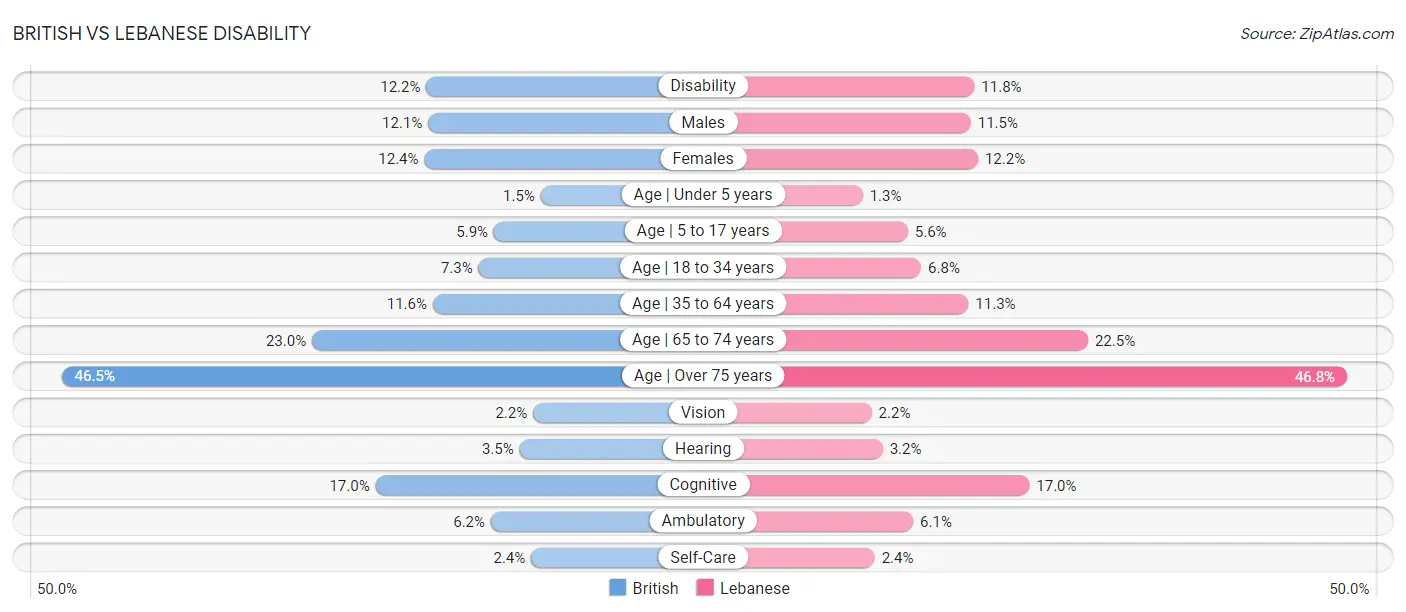
| Disability Metric | British | Lebanese |
| Disability | Tragic 12.2% | Fair 11.8% |
| Males | Tragic 12.1% | Poor 11.5% |
| Females | Poor 12.4% | Average 12.2% |
| Age | Under 5 years | Tragic 1.5% | Tragic 1.3% |
| Age | 5 to 17 years | Tragic 5.9% | Good 5.6% |
| Age | 18 to 34 years | Tragic 7.3% | Poor 6.8% |
| Age | 35 to 64 years | Poor 11.6% | Average 11.3% |
| Age | 65 to 74 years | Good 23.0% | Exceptional 22.5% |
| Age | Over 75 years | Exceptional 46.5% | Excellent 46.8% |
| Vision | Fair 2.2% | Average 2.2% |
| Hearing | Tragic 3.5% | Tragic 3.2% |
| Cognitive | Excellent 17.0% | Exceptional 17.0% |
| Ambulatory | Fair 6.2% | Good 6.1% |
| Self-Care | Exceptional 2.4% | Good 2.4% |